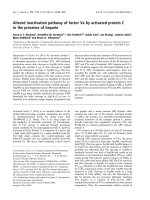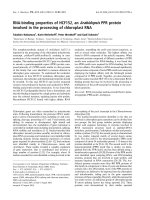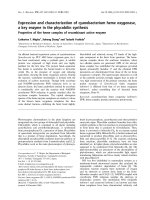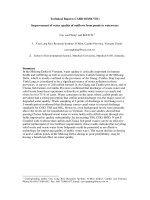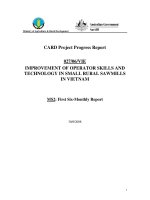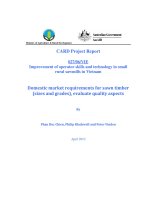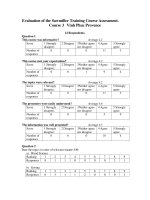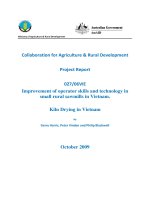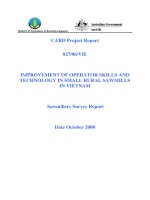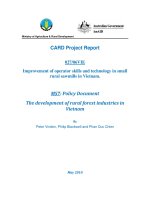Báo cáo khoa học nông nghiệp " Development of Better Management Practices for Catfish Aquaculture in the Mekong Delta, Vietnam " pptx
Bạn đang xem bản rút gọn của tài liệu. Xem và tải ngay bản đầy đủ của tài liệu tại đây (79.45 KB, 9 trang )
Development of Better Management Practices for Catfish
Aquaculture in the Mekong Delta, Vietnam
RISK ASSESSMENT
August, 2009
Introduction
For purposes of meeting medium-long term industry sustainability imperatives, the
development of Better Management Practices (BMPs) is considered a priority for the
catfish farming sector in the Mekong Delta of south Vietnam. To this end, the
following project entitled,:
Development of Better Management Practices for Catfish Aquaculture ibn the
Mekong Delta, Vietnam
has been funded by AusAid as part of the Collaboration for Agricultural Rural
Development (CARD 001/07/VIE). As part of this project it is a requirement to
undertake a formal risk assessment of the industry to identify information gaps and
key risks to be addressed by the proposed BMPs. This report is a summary of the key
findings and recommendations of this assessment.
Methods
This risk assessment is based on a modified combination of methods from the
National ESD Framework for aquaculture(Fletcher et al. 2004), Finfish Aquaculture
in Western Australia: Final ESD Risk Assessment Report for Sea-cage and Land-
based Finfish Aquaculture (Vom Berg 2008) and Risk Management Planning for DPI
Projects (Halligan and Linehan 2008).
The process for undertaking the risk assessment is as follows:
1. Compile initial Risk Register (list of key risks) categorised according to
generic BMP framework
2. Review score key risks in terms of ‘likelihood’ and ‘consequence’ of risks
occurring to provide Risk Ratings
3. Risk Ratings are ranked (= sum of likelihood + consequence scores) to
provide the Risk Ranking
4. Risk Ranking determines appropriate level of management response according
to Risk Ranking Matrix and associated BMP outcome.
The Risk Register (Attachment 1) was initially compiled by the CARD project team,
following a process of industry consultation, project planning workshops and
associated stakeholder needs analysis, field investigations in the Mekong Delta during
2008/09, and consideration of interim results for the recently completed socio-
economic survey of the catfish aquaculture industry in the Mekong Delta.
The generic framework used to summarise the risks is based on the key categories
(Table 1) used for many Better Management Practice (BMP) guidelines in the
aquaculture industry (Boyd 2003; Tucker 2003; De Silva et al. 2006; World Bank
2006; ADB/ACIAR/AwF/BRR/DKP/FAO/GTZ/IFC/MMAF/NACA/WWF 2007;
Florida Department of Agriculture and Consumer Services 2007; Tucker and
Hargreaves 2008), supplemented by categories of more contemporary and/or localised
relevance. These categories will subsequently form the basis of the draft Catfish
Aquaculture BMP for the Mekong Delta, according to the customised schematic
logframe (Attachment 2). The main aim of the risk assessment is to determine if
current management is sufficient and to consider risks on a prioritised basis to be used
in the development of a BMP for catfish farming. The original key categories
included a category for “Records”. This was combined into the “Markets, Regulation
& Finance” category as the specific risks identified under the Records category were
implicit in the Markets, Regulation & Finance category.
The risk ranking is determined using the risk analysis tool outlined in the Risk
Management Planning for DPI Projects, which was based on the Australian Standard
for Risk Management (Standards Australia 2004a,b). To assign a level of risk (= risk
ranking score) to an issue, two factors must be determined:
• the likelihood of a particular activity/event/circumstance occurring, and
• the consequence of this particular activity/event/circumstance, should it occur.
•
Table 1. BMP Key Categories
Site Selection & Farm Design
Culture System Preparation
Farm Management
Hatchery Management
Nursery Management
Seedstock Supply & Stocking
Feed Management
Water Management
Waste Management
Climate Change
Fish Health Management & Biosecurity
Post-Harvest
Markets, Regulation & Finance
Communications & Training
The format for the scoring of Risk Ratings is provided in Attachment 3, with
descriptions of scores and associated values summarised in Tables A3.1 & A3.2
(Attachment 3). Risk ratings are assigned a level of consequence (from ‘insignificant’
to ‘catastrophic’) and likelihood (from ‘rare’ to ‘almost certain’). This stage was
undertaken using an expert-panel consisting of the CARD project team, nominated
experts and key stakeholders associated with the catfish aquaculture sector in the
Mekong Delta, Vietnam. Seven risk assessments were completed; five by individual
experts (two individuals from Fisheries Victoria (Department of Primary Industries),
one from NACA, one from RIA2 and one from an industry consultant) and two by
groups of experts from CTU (group of four) and RIA2 (group of four). Each of the
seven risk assessments was assigned equal weight in consolidating and averaging the
scores for analysis. The combination of consequence and likelihood produces (as a
summation of risk rating scores) an estimate of the associated risk (= Risk Ranking
score). The Risk Ranking scores are then reconciled against the Risk Ranking Matrix
(Table 2) to identify the relative Risk Ranking Profile (Table 3) and appropriate BMP
response as a new and/or additional Control measure (Attachment 2).
Table 2. Risk Ranking Matrix
Consequence
Insignificant Minor Moderate Major Catastrophic
Likelihood 1 2 3 4 5
Almost
Certain
5
6 7 8 9 10
Likely
4
5 6 7 8 9
Possible
3
4 5 6 7 8
Unlikely
2
3 4 5 6 7
Rare
1
2 3 4 5 6
Table 3.
Risk Ranking Profile BMP Response
8-10 High Risk Mandatory
7 Significant Risk Recommended
5-6 Moderate Risk Optional
<5 Low Risk Not required
Results and Discussion
Complete results for risk assessment are provided in appendix 1. A summary of the
number of identified high, significant and moderate risks is summarised by BMP
category in table 4.
Table 4. Summary of risk levels by BMP Category
BMP Category High Risk Significant
Risk
Moderate
Risk
Site Selection & Farm Design 0 2 5
Culture System Preparation 0 1 1
Farm Management 0 5 6
Hatchery Management 0 2 4
Nursery Management 0 1 1
Seedstock Supply & Stocking 0 1 2
Feed Management 0 0 6
Water Management 2 3 1
Waste Management 0 1 2
Climate Change 0 2 2
Fish Health Management & Biosecurity 1 4 1
Post-Harvest 0 1 1
Markets, Regulation & Finance 1 6 3
Communications & Training 0 1 2
These findings will provide a key checklist against which draft BMPs will be
prepared for Project no. CARD 001/07/VIE, with specific emphasis on ensuring all
high, significant and moderate risks (Table 4) are appropriately addressed within each
of the designated BMP categories.
Acknowledgements
The following personnel contributed to this risk assessment:
College of Aquaculture and Fisheries, Can Tho University, Can Tho City, Vn
Dr Nguyen Thanh Phuong, Mr Bui Minh Tam, Mr Pham Thanh Liem and Mr Duong
Nhut Long
Research Institute for Aquaculture #2, Ho Chi Minh City, Vn
Dr Nguyen Van Hao, Mr Phan Lam, Mr. Tran Quoc Chuong, Mr.Doan Van Bay,
Mr.Ha Tan and Ms.Nguyen Thi Hoai An (Inland Fisheries Resources and Capture
Division)
Network of Aquaculture Centres in Asia-Pacific
Prof. Sena De Silva, Dr Thuy Nguyen and Mr Bryan Davy (consultant)
Fisheries Victoria, Department of Primary Industries, Australia
Dr Brett Ingram
Mr Geoff Gooley
References
ADB/ACIAR/AwF/BRR/DKP/FAO/GTZ/IFC/MMAF/NACA/WWF (2007). Better
management practices for tambak farming in Aceh. Asian Development Bank
ETESP, Australian Centre for International Agriculture Research, Food and
Agriculture Organization of the United Nations, International Finance
Corporation of the World Bank Group, Banda Aceh.
Boyd, C. E. (2003). Guidelines for aquaculture effluent management at the farm-level.
Aquaculture 226, 101-112.
De Silva, S. S., Amarasinghe, U. S., and Nguyen, T. T. T. (2006). Better-practice
approaches for culture-based fisheries development in Asia. ACIAR, ACIAR
Monograph No. 120.
Fletcher, W. J., Chesson, J., Fisher, M., Sainsbury, K. J., and Hundloe, T. J. (2004).
National ESD Reporting Framework: The 'How To' Guide for Aquaculture.
Version 1.1. FRDC, Canberra, Australia.
Florida Department of Agriculture and Consumer Services (2007). Aquaculture Best
Management Practices Manual - January 2007. Division of Aquaculture,
Tallahassee, Florida.
Halligan, S., and Linehan, C. (2008). Risk Management Planning for DPI Projects.
Practice Change Capacity Development Booklet No. 6.
Standards Australia (2004a). AS/NZS 4360:2004 Risk Management.
Standards Australia (2004b). HB 436:2004 Risk Management Guidelines -
Companion to AS/NZS 4360:2004.
Tucker, C. (2003). Best Management Practices for Flow-Through, Net-Pen,
Recirculating, and Pond Aquaculture Systems. United States Environmental
Protection Agency.
Vom Berg, F. (2008). Finfish Aquaculture in Western Australia: Final ESD Risk
Assessment Report for Sea-cage and Land-based Finfish Aquaculture.
Government of Western Australia - Department of Fisheries.
World Bank (2006). Guidelines for Environmental Management of Aquaculture
Investments in Vietnam. Institute of Fisheries Management Research Institute
for Aquaculture Number 1, Network of Aquaculture Centres in Asia-Pacific,
Can Tho University and World Wide Fund for Nature.
Appendix 1. Complete Risk Assessment Results
BMP
Category
Specific Risk
Mean
Risk
Score
Risk
Ranking
Profile
BMP
Response
Site Selection &
Farm Design
Increased disease/pathogen issues and
environmental degradation
7
Significant
Risk
Recommended
Site Selection &
Farm Design
Poor/unsustainable water abstraction
practices from river/stream/channels
degrades environment and/or impacts
public amenity
7
Significant
Risk
Recommended
Site Selection &
Farm Design
Poor/unsustainable land use practices
degrade the environment and/or impact
public amenity
6
Moderate
Risk
Optional
Site Selection &
Farm Design
Sewage from farm/surrounding area
discharged into culture area
6
Moderate
Risk
Optional
Site Selection &
Farm Design
Poor/unsustainable water use from
surrounding farms negatively effects
your farm
6
Moderate
Risk
Optional
Site Selection &
Farm Design
Poor farm design limits ability to farm
fish successfully
6
Moderate
Risk
Optional
Site Selection &
Farm Design
Poor farm productivity 5
Moderate
Risk
Optional
Site Selection &
Farm Design
Farm is vulnerable to extreme tides,
rain, weather
4 Low Risk Not required
Site Selection &
Farm Design
Theft/vandalism 4 Low Risk Not required
Culture System
Preparation
Ponds/equipment are not properly
disinfected between use
7
Significant
Risk
Recommended
Culture System
Preparation
Ponds are not adequately de-sludged
and/or pond banks not maintained
6
Moderate
Risk
Optional
Farm
Management
Reduced market price/demand 7
Significant
Risk
Recommended
Farm
Management
Poor quality effluent can negatively
affect the downstream environment
7
Significant
Risk
Recommended
Farm
Management
Increased incidence of disease related
losses
7
Significant
Risk
Recommended
Farm
Management
Poor husbandry practices can lead to
breaches of biosecurity
7
Significant
Risk
Recommended
Farm
Management
Excessive production costs 7
Significant
Risk
Recommended
Farm
Management
Data is collected but not communicated
and/or utilised
6
Moderate
Risk
Optional
Farm
Management
Poor husbandry practices 6
Moderate
Risk
Optional
Farm
Management
Insufficient skills/personnel 5
Moderate
Risk
Optional
Farm
Management
Insufficient/outdated/dysfunctional
infrastructure limit farm productivity
5
Moderate
Risk
Optional
Farm
Management
Increase incidence of OH&S issues for
employees
5
Moderate
Risk
Optional
Farm
Management
Loss of livelihood for local communities 5
Moderate
Risk
Optional
Hatchery
Management
Poor broodstock selection causing
genetic inbreeding can lead to reduced
quality of seedstock and overall
productivity
7
Significant
Risk
Recommended
Hatchery
Management
Hatchery quarantine systems not in
place or otherwise ineffective
7
Significant
Risk
Recommended
Hatchery
Management
Poor broodstock conditioning leads to
lower fecundity and/or poor quality
eggs/larvae
6
Moderate
Risk
Optional
Hatchery
Management
Poor water quality and/or unsuitable
temperature can lead to reduced to
reduced survival of eggs/larvae
6
Moderate
Risk
Optional
Hatchery
Management
Incorrect type/size/quantity of food
and/or poor water quality for first
feeding larvae leads to reduced survival
6
Moderate
Risk
Optional
Hatchery
Management
Inefficient breeding techniques lead to
poor quality and/or reduced offspring
6
Moderate
Risk
Optional
Nursery
Management
Nursery quarantine systems not in
place or otherwise ineffective
7
Significant
Risk
Recommended
Nursery
Management
Inadequate supply of larvae 5
Moderate
Risk
Optional
Seedstock
Supply &
Stocking
Poor quality seedstock can lead to poor
performance/high mortality
7
Significant
Risk
Recommended
Seedstock
Supply &
Stocking
Too many fish stocked and carrying
capacity is exceeded
6
Moderate
Risk
Optional
Seedstock
Supply &
Stocking
Lack of sufficient number of seedstock
at appropriate time
5
Moderate
Risk
Optional
Seedstock
Supply &
Stocking
Seedstock are not stocked at
appropriate time of year, time of day
(temperature)
4 Low Risk Not required
Seedstock
Supply &
Stocking
Seedstock are too expensive 4 Low Risk Not required
Feed
Management
Poor quality of feed ingredients 6
Moderate
Risk
Optional
Feed
Management
Excessive cost of feed ingredients 6
Moderate
Risk
Optional
Feed
Management
Lack of availability of feed ingredients 6
Moderate
Risk
Optional
Feed
Management
Feed ingredients are sourced by
unsustainable means (e.g. trash fish,
fish meal)
6
Moderate
Risk
Optional
Feed
Management
Incorrectly stored feed leads to reduced
performance/profitability
6
Moderate
Risk
Optional
Feed
Management
Inefficient feed delivery
methods/frequency leads to wasted
feed, poor water quality and productivity
5
Moderate
Risk
Optional
Feed
Management
Incorrect food type/size fed to different
size class fish
4 Low Risk Not required
Water
Management
Untreated water is discharged back into
the aquatic environment
8 High Risk Mandatory
Water
Management
Settlement ponds absent or not properly
designed or operated
8 High Risk Mandatory
Water
Management
Incomplete/inadequate monitoring fails
to identify water quality problems
7
Significant
Risk
Recommended
Water
Management
Intake water is not filtered for unwanted
organisms/pathogens
7
Significant
Risk
Recommended
Water
Management
Insufficient water exchange results in
poor pond water quality
7
Significant
Risk
Recommended
Water
Management
Lack of supplementary aeration leads to
dissolved oxygen problems
5
Moderate
Risk
Optional
Waste
Management
Reuse of the processing waste as a
feed ingredient creates health problems
7
Significant
Risk
Recommended
Waste
Management
Poor disposal of mortalities creates
productivity, health, environmental &
social problems
6
Moderate
Risk
Optional
Waste
Management
non-biodegradable waste is not properly
disposed of
5
Moderate
Risk
Optional
Climate Change
Land salinization and loss of sites from
rising sea level
7
Significant
Risk
Recommended
Climate Change
Climate change driven increase in
production costs
7
Significant
Risk
Recommended
Climate Change
New diseases and exotic organisms
impact productivity
6
Moderate
Risk
Optional
Climate Change
Inundation/damage leading to loss of
suitable sites
6
Moderate
Risk
Optional
Fish Health
Management &
Biosecurity
Disease/pathogen occurrence resulting
from inadequate monitoring,
management and treatment reduces
productivity
8 High Risk Mandatory
Fish Health
Management &
Biosecurity
Disease/pathogen occurrence in
effluent can affect other farms/general
environment
7
Significant
Risk
Recommended
Fish Health
Management &
Biosecurity
Introduction of disease/pathogen from
water supply
7
Significant
Risk
Recommended
Fish Health
Management &
Biosecurity
Improper chemical/pesticide use affects
health of fish
7
Significant
Risk
Recommended
Fish Health
Management &
Biosecurity
Introduction of disease/pathogens from
incoming seedstock/broodstock/trash
fish and/or human activity
7
Significant
Risk
Recommended
Fish Health
Management &
Biosecurity
Escaped fish alter genetics in natural
populations
5
Moderate
Risk
Optional
Fish Health
Management &
Biosecurity
Exotic species will be introduced to the
farm and affect productivity
4 Low Risk Not required
Fish Health
Management &
Biosecurity
Competition for food with wild stock due
to farm escapees
4 Low Risk Not required
Post-harvest
Ad hoc use of antibiotics and other
banned chemicals compromises food
safety
7
Significant
Risk
Recommended
Post-harvest
Consumer expectations not being met
for taste, appearance, nutritional value
(credence values)
5
Moderate
Risk
Optional
Markets,
Regulation &
Finance
Inability to comply with export market
standards (lack of or inappropriate
standards/certification/traceability
systems)
8 High Risk Mandatory
Markets,
Regulation &
Finance
Ineffective marketing of product and/or
promotion of industry credibility
7
Significant
Risk
Recommended
Markets,
Regulation &
Finance
Ineffective strategic development of
new & existing markets
7
Significant
Risk
Recommended
Markets,
Regulation &
Finance
Market chain lacks orderly structure &
functionality
7
Significant
Risk
Recommended
Markets,
Regulation &
Finance
Negative press from competitors 7
Significant
Risk
Recommended
Markets,
Regulation &
Finance
Inaccurate or absent data fails to inform
industry/government on performance
measures
7
Significant
Risk
Recommended
Markets,
Regulation &
Finance
Lack of industry compliance leads to
poor performance
7
Significant
Risk
Recommended
Markets,
Regulation &
Finance
Bureaucratic constraints from regulatory
processes
6
Moderate
Risk
Optional
Markets,
Regulation &
Finance
Inability to fund investment/operating
costs/expansion
6
Moderate
Risk
Optional
Markets,
Regulation &
Finance
Increased competition from
new/existing players
6
Moderate
Risk
Optional
Communication &
Training
Poor information exchange on
price/quality/demand
7
Significant
Risk
Recommended
Communication &
Training
Lack of skills and/or people 6
Moderate
Risk
Optional
Communication &
Training
Ineffective communication/networking
between government, technical experts,
and farmers prevents implementation of
BMP
6
Moderate
Risk
Optional
